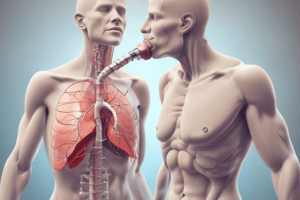Podcast
Questions and Answers
Which of the following is a key measurement in spirometry?
Which of the following is a key measurement in spirometry?
- Forced Vital Capacity (FVC) (correct)
- Total Lung Capacity (TLC)
- Diffusion Capacity of the Lung for Carbon Monoxide (DLCO)
- Residual Volume (RV)
What is the primary function of lung volume measurements?
What is the primary function of lung volume measurements?
- To measure the ability of the lungs to transfer oxygen into the blood
- To diagnose restrictive lung diseases (correct)
- To diagnose obstructive lung diseases
- To monitor response to therapy
Which of the following is a key component of lung volumes?
Which of the following is a key component of lung volumes?
- Functional Residual Capacity (FRC) (correct)
- Forced Expiratory Volume (FEV1)
- Diffusion Capacity of the Lung for Carbon Monoxide (DLCO)
- FEV1/FVC ratio
What is the primary function of diffusion capacity?
What is the primary function of diffusion capacity?
Which of the following is a key measurement in diffusion capacity?
Which of the following is a key measurement in diffusion capacity?
Spirometry is used to diagnose and monitor which type of lung diseases?
Spirometry is used to diagnose and monitor which type of lung diseases?
What is the normal pH range for a patient?
What is the normal pH range for a patient?
A patient's blood gas result shows a pH of 7.25 and a pCO2 of 50 mmHg. What is the primary disorder?
A patient's blood gas result shows a pH of 7.25 and a pCO2 of 50 mmHg. What is the primary disorder?
A patient's blood gas result shows a pH of 7.50 and a HCO3- of 28 mmol/L. What is the primary disorder?
A patient's blood gas result shows a pH of 7.50 and a HCO3- of 28 mmol/L. What is the primary disorder?
What is the primary cause of respiratory acidosis?
What is the primary cause of respiratory acidosis?
A patient's blood gas result shows a pH of 7.30 and a pCO2 of 35 mmHg. What is the next step in interpreting the results?
A patient's blood gas result shows a pH of 7.30 and a pCO2 of 35 mmHg. What is the next step in interpreting the results?
Flashcards are hidden until you start studying
Study Notes
Pulmonary Function Tests
Spirometry
- Measures lung function by assessing airflow and lung volumes
- Key measurements:
- Forced Vital Capacity (FVC): total volume of air exhaled from the lungs
- Forced Expiratory Volume (FEV1): volume of air exhaled in the first second
- FEV1/FVC ratio: proportion of FVC exhaled in the first second
- Spirometry is used to:
- Diagnose and monitor obstructive lung diseases (e.g., asthma, COPD)
- Evaluate lung function in patients with respiratory symptoms
- Monitor response to therapy
Lung Volumes
- Measures the total amount of air in the lungs
- Key components:
- Total Lung Capacity (TLC): total volume of air in the lungs
- Residual Volume (RV): volume of air remaining in the lungs after exhalation
- Functional Residual Capacity (FRC): volume of air in the lungs at the end of normal exhalation
- Lung volume measurements are used to:
- Diagnose restrictive lung diseases (e.g., pulmonary fibrosis)
- Evaluate lung function in patients with respiratory symptoms
- Monitor response to therapy
Diffusion Capacity
- Measures the ability of the lungs to transfer oxygen from the air into the blood
- Key measurement:
- Diffusion Capacity of the Lung for Carbon Monoxide (DLCO): measures the rate of CO transfer from the air into the blood
- Diffusion capacity is used to:
- Diagnose and monitor lung diseases that affect gas exchange (e.g., emphysema, pulmonary hypertension)
- Evaluate lung function in patients with respiratory symptoms
- Monitor response to therapy
Pulmonary Function Tests
Spirometry
- Assesses airflow and lung volumes to measure lung function
- Provides three key measurements:
- Forced Vital Capacity (FVC): total air volume exhaled from lungs
- Forced Expiratory Volume (FEV1): air volume exhaled in the first second
- FEV1/FVC ratio: proportion of FVC exhaled in the first second
- Used for:
- Diagnosing and monitoring obstructive lung diseases (e.g., asthma, COPD)
- Evaluating lung function in patients with respiratory symptoms
- Monitoring response to therapy
Lung Volumes
- Measures total air volume in the lungs
- Comprises three key components:
- Total Lung Capacity (TLC): total air volume in the lungs
- Residual Volume (RV): air volume remaining in the lungs after exhalation
- Functional Residual Capacity (FRC): air volume in the lungs at the end of normal exhalation
- Used for:
- Diagnosing restrictive lung diseases (e.g., pulmonary fibrosis)
- Evaluating lung function in patients with respiratory symptoms
- Monitoring response to therapy
Diffusion Capacity
- Measures the rate of oxygen transfer from air into the blood
- Key measurement:
- Diffusion Capacity of the Lung for Carbon Monoxide (DLCO): CO transfer rate from air into the blood
- Used for:
- Diagnosing and monitoring lung diseases affecting gas exchange (e.g., emphysema, pulmonary hypertension)
- Evaluating lung function in patients with respiratory symptoms
- Monitoring response to therapy
Interpreting ABG Results
Acid-Base Status
- pH level: normal range is 7.35-7.45
- Acidosis: pH level is less than 7.35
- Alkalosis: pH level is greater than 7.45
Identifying Primary Disorder
- Respiratory Acidosis:
- Characterized by high pCO2 (>45 mmHg)
- Low pH (<7.35) due to high pCO2
- May be caused by hypoxia (oxygen saturation <95%)
- Respiratory Alkalosis:
- Characterized by low pCO2 (<35 mmHg)
- High pH (>7.45) due to low pCO2
- Metabolic Acidosis:
- Characterized by low HCO3- (<22 mEq/L)
- Low pH (<7.35) due to low HCO3-
- Metabolic Alkalosis:
- Characterized by high HCO3- (>26 mEq/L)
- High pH (>7.45) due to high HCO3-
Studying That Suits You
Use AI to generate personalized quizzes and flashcards to suit your learning preferences.



